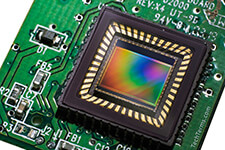CMOS
Stands for "Complementary Metal Oxide Semiconductor." It is a technology used to produce integrated circuits. CMOS circuits are found in several types of electronic components, including microprocessors, batteries, and digital camera image sensors.
The "MOS" in CMOS refers to the transistors in a CMOS component, called MOSFETs (metal oxide semiconductor field-effect transistors). The "metal" part of the name is a bit misleading, as modern MOSFETs often use polysilicon instead of aluminum as the conductive material. Each MOSFET includes two terminals ("source" and "drain") and a gate, which is insulated from the body of the transistor. When enough voltage is applied between the gate and body, electrons can flow between the source and drain terminals.
The "complimentary" part of CMOS refers to the two different types of semiconductors each transistor contains — N-type and P-type. N-type semiconductors have a greater concentration of electrons than holes, or places where an electron could exist. P-type semiconductors have a greater concentration of holes than electrons. These two semiconductors work together and may form logic gates based on how the circuit is designed.
CMOS Advantages
CMOS transistors are known for their efficient use of electrical power. They require no electrical current except when they are changing from one state to another. Additionally, the complimentary semiconductors work together to limit the output voltage. The result is a low-power design that gives off minimal heat. For this reason, CMOS transistors have replaced other previous designs (such as CCDs in camera sensors) and are used in most modern processors.
NOTE: CMOS memory in a computer is a type of non-volatile RAM (NVRAM) that stores BIOS settings and date/time information.
 Test Your Knowledge
Test Your Knowledge